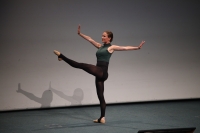During the opening ceremony of the VPH conference, a lecture-performance featured physiologically based dancing digital twins. This could lay the basis for a new patient-centric and preventive healthcare system.

For the last 20+ years, Gunnar Cedersund, at Linköping University in Sweden, has collaborated with a large number of pre-clinical and clinical research groups, to develop and test mechanistic mathematical models for most of the main organs in the human body (Fig 1A)1-12.

Lately, Cedersund has created a reusable backend (B) to an eHealth platform (C), where the organ-models are interconnected, and where the models can be personalized, and used to simulate scenarios (D-E). These scenarios can span from inside cells to the whole-body (multi-level), from seconds to decades (multi-timescale), across all main organs (multi-organ), in a mechanistic way (M4). At the recently held Virtual Physiological Human (VPH) conference, some of these new possibilites were presented.
A lecture-performance with dancing digital twins
The opening ceremony of the VPH conference started with a special type of event: a lecture-performance, featuring dancing digital twins. The first part was a quick overview of the technological basis for the digital twins, and created the connection to the main topic of the conference. This part showed how digital twins can be used to understand and explore one of our greatest mysteries: how life and the human body is structured. The second part then used the digital twins to explore one of the other great mysteries: music, and especially the most profound pieces in the classical music literature. This latter exploration was done by creating a choreography together with Julia Bengtsson, one of the best ballet dancers in the world, who has performed as a soloist in places like Carnegie Hall and the UN headquarters. This choreography featured not only Bengtsson as a soloist, but also dancing digital twins – all to the live piano music of Cedersund.

Figure 2: The opening slide of the lecture performance, opening the opening ceremony of the VPH conference. A short clip from the audience is available e.g. here.
Future vision: to have these digital twins follow you throughout your entire health journey
The vision for future developments of this lecture-performance is to allow audience members to bring their own digital twins with them: to use augmented reality to allow everyone to see a twin for themselves on stage, dancing advanced performances. The audience members should also be able to look inside of the bodies of their digital twins, into the organs, and into the cells. This opens the door to many other applications, e.g. within teaching of biomedical concepts to students, or within preventive and patient-centric care. In some other presentations during the VPH conference, some of these other possibilities were also presented. For instance, Oscar Arrestam presented a recently published digital twin model, which allows you to see the short- and intermediate impacts of changing what and when you eat, using a new more detailed model for liver metabolism10. Together with hybrid machine learning models, this could be used to present different future scenarios, e.g. using preventive health conversations (Fig 1E)11-12. Finally, at the end of the VPH conference, Gunnar Cedersund gave a second, normal, lecture outlining the software architecture behind the digital twin technology (Fig 1B). This architecture is done to allow a variety of different eHealth apps to connect to the same backend (Fig 1C). The idea is that this should allow patients to bring their digital twins with them, across their entire health journey: from normal life, to preventive care, acute treatment, and rehabilitation, in relation to a growing number of disesases, such as diabetes and stroke (precise4q.eu).
REFERENCES
[1> Nyman et al, CPT Pharmacometrics Syst Pharmacol. 2020, 9(12):707-717 [2] Sten S et al, Neuroimage. 2017 158:219-231 [3] Sten S et al, bioRxiv, 2021, 03.25.437053 [4] Casas B et al, Front Physiol, 2018, 9:1515 [5] Palmér et al, CPT Pharmacometrics Syst Pharmacol, 2014, 3:e118 [6] Cedersund G, M.Sc. Th, DTU, 2001 [7] Brännmark C et al, J Biol Chem. 2013 288(14):9867-80 [8] Herrgårdh T et al, Front Physiol. 2021, 12:619254 [9] Silfvergren O et al, PLoS Comp Biol, 2022, 18(9): e1010469 [10] Lövfors et al, bioRxiv, 2022, 10.1101/2022.03.11.483974 [11] Herrgårdh T et al, Neuroimage Clin. 2021, 31:102694 [12] Herrgårdh T et al, bioRxiv, 2022, 10.1101/2022.03.25.485803